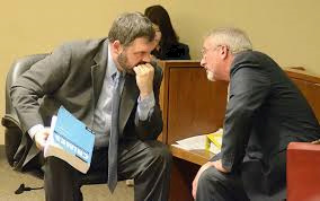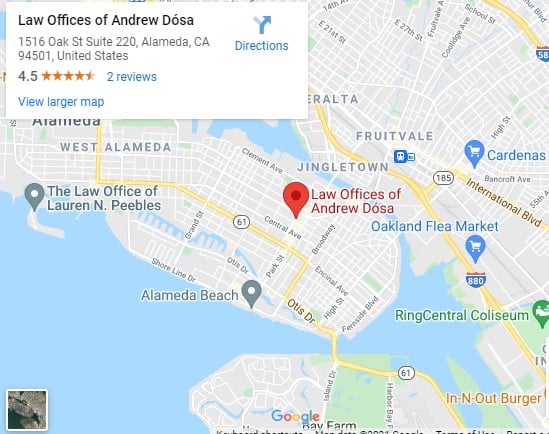It is commonly assumed that when a jury renders a verdict, the case is done. But that is not true. And, beyond the rare times when there is jury misconduct, or other impropriety allowing the verdict to be vacated, Penal Code Sec. 1181 gives statutory help for a defendant in other situations. There are nine situations when the court may grant a defendant a new trial:
- the defendant was absent, outside of exceptions allowing his absence;
- the jury received evidence out of court;
- the jury has separated during deliberations, or there was misconduct preventing a fair and due consideration of the case;
- the jury decided by lot or employed means other than a fair expression of opinion by each juror;
- the court misdirected the jury in a matter of law or erred in deciding a question of law arising during the trial, and when the prosecutor misconduct prejudiced defendant;
- the verdict or finding is contrary to law or evidence, in which case the judge may modify the verdict or finding;
- the verdict or finding is contrary to law or evidence, in which case the court may modify the verdict or finding and impose a lesser punishment;
- new evidence is discovered material to the defendant, and which he could not, with reasonable diligence, have discovered and produced at the trial; and
- when it is not possible to have a phonographic report of the trial.
The case law also offers clarity, but the language seems stark and surprising. A judge is obligated to substitute her opinion instead of the jury’s if the judge does not believe the evidence is sufficient to meet the “beyond reasonable doubt” standard. The judge must use her independent judgment:
[A] defendant tried by jury is entitled to two decisions on the evidence, one by the jury and another by the trial judge in passing upon a motion for a new trial, and it is [the judge’s] duty to grant a new trial if he is not satisfied that evidence is sufficient to sustain the verdict….” (People v. Creswell (1953) 119 Cal.App.2nd 584, 586).
Additionally:
Although the trial court is to be guided by a presumption in favor of the correctness of the jury’s verdict this means only that the court may not arbitrarily reject a verdict that is supported by substantial evidence. The trial court is not bound by the jury’s determinations as to the credibility of witnesses or as to the weight of effect to be accorded to the evidence. Thus, the presumption that the verdict is correct does not affect the trial court’s duty to give the defendant the benefits of its independent determination as to the probative value of the evidence [admitted pursuant to proper instructions on the applicable law]. If the court finds that the evidence [as instructed upon] is not sufficiently probative to sustain the verdict, it must order a new trial. (People v. Dickens (2005)130 Cal.App.4 1235, 1251-1252 (internal citations and quotations omitted.)
There you have it. There is one final “jury” out there, during the trial. It is the judge.
An example of a Motion for a New Trial we filed in an attempted murder case can be reviewed below:
Andrew Alexander Dósa (State Bar #113106)
Law Offices of Andrew Dósa
1516 Oak Street, Suite 220
Alameda, California 94501
T: 510-333-4564
Fax: 844-584-6052
eMail: adosa@dosalaw.com
Attorney for Defendant
SUPERIOR COURT OF CALIFORNIA, COUNTY OF ALAMEDA
| THE PEOPLE OF THE STATE OF CALIFORNIA,
Plaintiff. – vs. – FAB, Defendant. ________________________________/ |
Case No. 19-CR-xxxxxx
NOTICE OF MOTION AND MOTION FOR NEW TRIAL (PC SEC. 1181); POINTS AND AUTHORITIES IN SUPPORT THEREOF Date: Time: 9:00 a.m. Dept: 6 |
|
TO THE CLERK OF THE SUPERIOR COURT, COUNTY OF ALAMEDA AND TO THE DISTRICT ATTORNEY FOR THE COUNTY OF ALAMEDA:
PLEASE TAKE NOTICE that on October 4, 2021, at 9:00 a.m. in Department 6 of the above-entitled Court, Defendant will move to for a new trial, on the ground that, among other things, the evidence presented at the trial was insufficient to justify a verdict of guilty, a witness was absent due to illness, and the Court should have included Jury Instructions for a lesser included offense to Attempted Murder. This motion is based on the attached memorandum of points and authorities, Penal Code Section 1181, defendant’s state and federal constitutional rights to due process of law, evidence presented at the hearing, and oral argument at the hearing
Dated: September 1, 2000
Andrew Alexander Dósa, Esq.
Attorney for Defendant
MEMORANDUM OF POINTS AND AUTHORITIES
STATEMENT OF FACTS
About 1:00 a.m., in 2000, Defendant B drove his truck into trouble. He had an alibi, and could not have gotten into trouble.
LEGAL AUTHORITY
Penal Code Section 1181, in pertinent part, provides:
When a verdict has been rendered or a finding made against the defendant, the court may, upon his application, grant a new trial, in the following cases only:
* * *
- When the court has misdirected the jury in a matter of law, or has erred in the decision of any question of law arising during the course of the trial, and when the district attorney or other counsel prosecuting the case has been guilty of prejudicial misconduct during the trial thereof before a jury;
- When the verdict or finding is contrary to law or evidence, but if the evidence shows the defendant to be not guilty of the degree of the crime of which he was convicted, but guilty of a lesser degree thereof, or of a lesser crime included therein, the court may modify the verdict, finding or judgment accordingly without granting or ordering a new trial, and this power shall extend to any court to which the cause may be appealed;
- When the verdict or finding is contrary to law or evidence, but in any case wherein authority is vested by statute in the trial court or jury to recommend or determine as a part of its verdict or finding the punishment to be imposed, the court may modify such verdict or finding by imposing the lesser punishment without granting or ordering a new trial, and this power shall extend to any court to which the case may be appealed;
- When new evidence is discovered material to the defendant, and which he could not, with reasonable diligence, have discovered and produced at the trial. When a motion for a new trial is made upon the ground of newly discovered evidence, the defendant must produce at the hearing, in support thereof, the affidavits of the witnesses by whom such evidence is expected to be given, and if time is required by the defendant to procure such affidavits, the court may postpone the hearing of the motion for such length of time as, under all circumstances of the case, may seem reasonable.
* *
- THE COURT SHOULD EXERCISE ITS INDEPENDENT JUDGMENT, SITTING AS THE THIRTEENTH JUROR, TO FIND THE JURY REACHED A VERDICT OF GUILTY DESPITE THE FAILURE OF THE PROSECUTION TO PROVE BEYOND A REASONABLE DOUBT THAT MR. B WAS GUILTY OF ANY OF THE CHARGES
Defendant respectfully requests this Court to exercise its independent judgment pursuant to Penal Code §1181(6) and order a new trial. Before this Court imposes judgement it ought independently to conclude that B was proven guilty beyond a reasonable doubt of each count. It is a maxim in California’s jurisprudence that: “[A] defendant tried by jury is entitled to two decisions on the evidence, one by the jury and another by the trial judge in passing upon a motion for new trial, and it is [the judge’s] duty to grant new trial if he is not satisfied that evidence is sufficient to sustain the verdict….” (People v. Creswell (1953) 119 Cal.App.2nd 584, 586).
Additionally:
Although the trial court is to be guided by a presumption in favor of the correctness of the jury’s verdict this means only that the court may not arbitrarily reject a verdict which is supported by substantial evidence. The trial court is not bound by the jury’s determinations as to the credibility of witnesses or as to the weight of effect to be accorded to the evidence. Thus, the presumption that the verdict is correct does not affect the trial court’s duty to give the defendant the benefits of its independent determination as to the probative value of the evidence [admitted pursuant to proper instructions on the applicable law]. If the court finds that the evidence [as instructed upon] is not sufficiently probative to sustain the verdict, it must order a new trial. (People v. Dickens (2005)130 Cal.App.4 1235, 1251-1252 (internal citations and quotations omitted.)
This court must independently apply to that evidence the legal rules that should control a fact finder’s decision in such a case: first, that the evidence in the record must be rationally inconsistent with any conclusion other that of the defendant’s guilt; and second, that each fact essential to complete a set of circumstances necessary to establish the defendant’s guilt must be proven beyond a reasonable doubt. CALCRIM 224.
The Court has broad discretion to determine if the evidence was sufficiently probative to sustain the verdict. People v. Roberge (1953) 41 Cal.2d 628, 633.
The proof employed in this prosecution was based entirely on circumstantial evidence, and essentially phantom evidence. There was no gun. There was no bullet. There was no evidence B had any motive or anger against S or any intent to harm her. There was not substantial evidence. There was no evidence, and the court can and should reject the verdict. S was drunk, as the blood test at the hospital showed, along with being under the influence of cocaine. But she said exactly one honest thing: she did not know if he had a gun.
Of course, if the court were to deny the Motion, it would have overlooked S’s credibility and reliability gap. The court would also have to reject the testimony of every witness, as each gave evidence that contradicted her testimony in some significant way. The court would also have to assume assume Mr B drove the truck, had a gun, had some animus toward S, and intended to harm her.
THE MAIN FACTUAL ISSUES: INSUFFICIENT EVIDENCE FOR A CONVICTION OF ANY COUNT ALLEGED:
Where was the gun? What evidence is there that B possessed a gun? If Ms. S got shot while in her car, why was there no bullet produced in evidence or found in the car? There was no bullet found in her car. There is also no evidence of any damage inside the car from a bullet. Both windows on the passenger side of the car were up.
Assuming for the sake of discussion, B had a gun, what evidence is there that he intended to shoot her? What if the weapon was fired accidentally, or through gross negligence, or reckless disregard?
Was S reliable?
What suggested Ms. S was reliable. She was inconsistent and she was simply wrong about several things. For a start, she claimed she was sober. Yet, at the hospital, her blood alcohol was measured as 0.0139. She was also a crack head, and after scoring her nightly hit, she did not consume the cocaine. She was practicing delayed gratification by storing it in the console of her car.
As noted below, she also did not have a firm grasp of reality.
Ever witness who testified included some evidence that contradicted her testimony.
- WHEN A WITNESS GETS SICK AND CANNOT TESTIFY, THE ABSENCE OF THAT TESTIMONY IS AKIN TO THE SITUATION WHERE THERE IS NEWLY DISCOVERED EVIDENCE.
K was in the hallway when she had a panic attack. She was taken by ambulance to the hospital that afternoon. The court had the case proceed without a continuance.
What is there to make of this testimony? The court has to consider if a “different result would be probably” at retrial. This “does not mean more likely than not, but merely a reasonable chance, more than abstract possibility.” C.E.B. California Criminal Law: Procedure and Practice, Page 1008, §34.9, citing People v. Watson (1956) 46 Cal.2d 818, 837. Italics original.
Further, the testimony of L would not be merely as impeachment, or to contradict a witness of the opposing party. Id., citing People v. Hall (2010) 187 Cal.App.4th 282, 299. L would prove an essential fact, that Ms. S was not at the location of the encampment when Shot Spotter alerted to a gun shot at that time, and, in fact, even had she been there, she could not have parked where she said she did, and where she said she got shot–as L’s truck was immobilized and at the spot.
III. THE COURT DID NOT INSTRUCT THE JURY ON LESSER INCLUDED
OFFENSES. THE COURT HAS A SUA SPONTE DUTY TO INSTRUCT ON LESSER INCLUDED OFFENSES, WHETHER OR NOT COUNSEL REQUESTED INSTRUCTIONS
The court has a sua sponte duty to instruct on lesser included offenses.
California law has long provided that even absent a request, and over any party’s objection, a trial court must instruct a criminal jury on any lesser offense ‘necessarily included in the charged offense, if there is substantial evidence that the lesser crime was committed. This venerable instructional rule ensures that the jury may consider all supportable crimes necessarily included within the charge itself, thus encouraging the most accurate verdict permitted by the pleadings and the evidence. (People v.Birks (1998) 19 Cal. 4th 108, 112.)
The sua sponte duty to instruct is designed to protect not only a defendant’s “constitutional right to have the jury determine every material issue presented by the evidence” but also “the broader interest of safeguarding the jury’s function of ascertaining the truth.” (People v. Cole (2004) 33 Cal. 4th 1158, 1215.) The duty extends to every lesser included offense supported by substantial evidence; it is not satisfied “when the court instructs [solely] on the theory of that offense most consistent with the evidence and the line of defense pursued at trial. (People v. Braverman (1998) 19 Cal. 4th 142, 153; People v. Anderson (2006) 141 Cal.App. 4th 430, 442.)
There are two tests to determine what constitutes a lesser included offense: the elements test and the accusatory pleading test.2 As the court can imagine,
the sua sponte rule insures that the jury will be exposed to the full range of verdict options which, by operation of law and with full notice to both parties, are presented in the accusatory pleading itself and are thus closely and openly connected to the case. In this context, the rule prevents either party, whether by design or inadvertence, from forcing an all-or-nothing choice between conviction of the stated offense on the one hand, or complete acquittal on the other.3 Hence, the rule encourages a verdict, within the charge chosen by the prosecution, that is neither “harsher[n]or more lenient than the evidence merits.” (Anderson (supra) 141 Cal.App.4th, 443 (citations omitted.)
Unlike the defendant in Anderson who was charged with felony murder, B was charged with attempted murder. Accidental/negligent and reckless conduct shooting were alternate/lesser included offenses. (cf. People v. Seaton (2001) 26 Cal.4th 598, 672 (second degree murder); People v. Randle (2005) 35 Cal.4th 987, 994 (manslaughter).) Accordingly, the trial court here should have given instructions on the lesser included offenses.
At first blush, it is curious to propose this argument. Could there be a lesser included offense to attempted murder? The discussion involves, in particular, the intent part of the crime(s). If the jury imagined from the slim facts of the case that B actually intended to harm S, we could guess that the jury could just as easily imagine the gun went off accidentally, or after reckless disregard of B for the safety of S or others.
- DEFENDANT B SUFFERED EXTREME PREJUDICE DUE TO THE COURT’S ALL OR NOTHING RULING
Defendant B suffered extreme prejudice by the Court’s all or nothing ruling on the charge of attempted murder. As the court stated in Barton (infra):
Truth may lie neither with the defendant’s protestations of innocence nor with the prosecution’s assertion that the defendant is guilty of the offense charged, but at a point between these two extremes: the evidence may show that the defendant is guilty of some intermediate offense included within, but lesser than, the crime charged. A trial court’s failure to inform the jury of its option to find the defendant guilty of the lesser offense would impair the jury’s truth-ascertainment function. Consequently, neither the prosecution not the defense should be allowed, based on their trial strategy, to preclude the jury from considering guilt or a lesser offense included in the crime charged. To permit this would force the jury to make an “all or nothing” choice Between conviction of the crime charged or complete acquittal, thereby denying the jury the opportunity to decide whether the defendant is guilty of a lesser included offense established by the evidence. (People v.Barton (1995) 12 Cal.4th 186, 196).
The failure of the Court to include the less crime of recklessness with a firearm clearly precluded counsel from arguing the panoply of lesser included offenses, thereby placing the jury in an “all or nothing” position with respect its verdict. The court’s error in this regard was of Constitutional dimension as it denied defendant due process and equal protection of law. Accordingly, this court ought to grant B’s motion for new trial because it’s “attempted murder or nothing” instructions resulted in extreme prejudice to defendant’s presentation of his defense, and to the jury’s range of decisions on the evidence.
The jury in the present case was deprived of the proper instructions on the law of lesser included offenses. When and if the jury had been properly instructed defendant may well have obtained a different result than conviction of attempted murder. Defendant is 63, and he may not survive to see a parole board pursuant to the term prescribed by law. Now therefore, it is respectfully submitted that the court exercise its independent judgement and grant the motion for new trial.
CONCLUSION
Based on the incomplete, unreliable, and unbelievable testimony of Ms. S, we have no evidence B had a gun or that she was shot in her car (where was the bullet?), and we have no evidence B was the driver of the vehicle that came along side her. There was no evidence the driver of that vehicle was the shooter. Also, significantly, we have no evidence of the intent/mental state of B. Assuming for the sake of discussion, and he possessed a gun, what was his intent? Murder? Or was he negligent? Or recklessless disregarding the potential harm of others?
If the jury had the option of even the lesser intend of reckless disregard, and had believed he ought to be convicted, B would be in an entirely different position at sentencing. He might not be facing a life sentence.
Respectfully submitted,
Dated: September 13, 2000
Andrew Alexander Dósa, Esq.
Attorney for Defendant B
1 Although the line of defense pursued at trial included the alibi, the court’s erroneous failure to give lesser included offenses to the offense of attempted murder foreclosed defense arguing to the jury there was an accidental shooting.
2 “A particular offense is considered a ‘lesser included offense,’ and therefore subject to the duty, if it satisfies one of two tests. The ‘elements’ test is satisfied if the statutory elements of the greater offense include all the elements of the lesser, so that the greater cannot be committed without committing the lesser; the ‘accusatory pleading’ test is satisfied if the facts actually alleged in the accusatory pleading include all the elements of the lesser offense, such that the greater offense cannot be committed without committing the lesser offense. (Anderson (supra) 141 Cal.App.4th 430, 442-443; citing People v. Cook (2001) 91 Cal.App. 4th 910, 918) In most cases this is a distinction without difference.
3 This is exactly what happened in our case.





